Vulnerability and Resilience Analysis of the Air Traffic Control Sector Network in China
Abstract
1. Introduction
- By combining the control sector with complex networks, this paper enriches the research scope of aviation networks, which provides an alternative perspective and a new comparative investigation to studies in airport networks and air route networks.
- We investigated the relationship between vulnerability and resilience of the ATC sector network under disruptive events, which fills one research gap in the air transportation community by improving the understanding of this type of complex system.
- The results have practical implications that can be used to effectively evaluate the vulnerability of the ATC sector network and improve the network resilience, reducing flight delay and air traffic congestion, and thus improving the efficiency of airspace operation. Also, the research method and approach demonstrated in this paper is transferable to other infrastructure systems as well.
2. Materials and Methods
2.1. Control Sectors Network Construction
- Each sector is considered as a node, and the edge is constructed according to flight flow relationships between adjacent sectors;
- If sector A has a flight to sector B, we consider that there is an undirected edge between A and B;
- Sectors are divided into high-altitude sectors and low-altitude sectors. If sectors of different heights have the same projection on a two-dimensional plane, these sectors are considered as one node.
- The ATC sector network model is an undirected weighted network. The weight of a sector node is the sum of the flights connecting all edges of the sector.
2.2. Network Centrality
2.3. The Vulnerability of CASN
2.3.1. Network Efficiency
2.3.2. Maximum Connected Subgraph Relative Value
2.4. The Resilience of CASN
- Firstly, random attack and deliberate attack are carried out on CASN, respectively to simulate the external disturbance suffered by the network. Among them, deliberate attack includes degree attack (DA) and betweenness attack (BA). Then, with the increase of time, the external disturbance gradually disappears, and different recovery strategies are adopted to improve the performance of the network. The recovery modes are random recovery (RR) and deliberate recovery, including degree recovery (DR) and betweenness recovery (BR). In addition, the sequence recovery (SR) mode is added for a random attack, that is, the node fails first and recovers first.
- When external disturbance occurs, it is assumed that 5% of nodes fail at . Then, the 10% of nodes fails at the next period, until 50% of the nodes fail at ; When the disturbance disappears, the system performance starts to recover at . In the recovery phase, the number of recovered nodes at each period corresponds to the number of failed nodes in the disruptive phase until all failed nodes are restored. The changes in network efficiency and maximum connected subgraph relative value are studied under different attack and recovery strategies, and then the resilience values are calculated through the proposed index.
3. Data Acquisition and Description
4. Results and Discussion
4.1. Empirical Analysis of CASN
4.1.1. Statistical Analysis
4.1.2. Network Characteristics Analysis
4.2. Vulnerability Analysis of CASN
4.3. Resilience Measurement of CASN
4.4. Comparative Analysis between CASN’s Vulnerability and Resilience
5. Conclusions
Author Contributions
Funding
Conflicts of Interest
References
- Ren, G.; Lu, C.; Zhu, J.; Liu, X. Analyzing the topological characteristic and key nodes of Chinese air sector network. Int. J. Mod. Phys. B 2019, 33, 112–121. [Google Scholar] [CrossRef]
- Janssen, M.A.; Schoon, M.L.; Ke, W. Scholarly networks on resilience, vulnerability and adaptation within the human dimensions of global environmental change. Glob. Environ. Chang. 2006, 16, 240–252. [Google Scholar] [CrossRef]
- Xu, Y. Study of Robustness in Cmplex Interconnected System and Networks; Publishing House of Electronics Industry: Beijing, China, 2015; pp. 30–45. [Google Scholar]
- Ouyang, M.; Zhao, L.; Pan, Z.; Hong, L. Comparisons of complex network based models and direct current power flow model to analyze power grid vulnerability under intentional attacks. Physica A 2014, 403, 45–53. [Google Scholar] [CrossRef]
- Wang, K. Research on Structural Complexity and Vulnerability of Power Grids Based on Complex Network Theory. Ph.D. Thesis, Huazhong University of Science and Technology, Wuhan, China, 2011. [Google Scholar]
- Wang, Z.; Chen, G.; Hill, D.J.; Dong, Z. A power flow based model for the analysis of vulnerability in power networks. Physica A 2016, 460, 105–115. [Google Scholar] [CrossRef]
- Sun, D.; Guan, S. Measuring vulnerability of urban metro network from line operation perspective. Transp. Res. Part A Policy Pract. 2016, 94, 348–359. [Google Scholar] [CrossRef]
- Kim, S.; Yeo, H. A Flow-based Vulnerability Measure for the Resilience of Urban Road Network. Proced. Soc. Behav. Sci. 2016, 218, 13–23. [Google Scholar] [CrossRef]
- Viljoen, N.M.; Joubert, J.W. The vulnerability of the global container shipping network to targeted link disruption. Physica A 2016, 462, 396–409. [Google Scholar] [CrossRef]
- Wilkinson, S.M.; Dunn, S.; Ma, S. The vulnerability of the European air traffic network to spatial hazards. Nat. Hazards 2012, 60, 1027–1036. [Google Scholar] [CrossRef]
- Nimmegeers, P.; Telen, D.; Beetens, M.; Logist, F.; Impe, J.V. Robust multi-objective optimal control of dynamic biological networks. Comput. Aided Chem. Eng. 2016, 38, 433–438. [Google Scholar]
- Çolak, S.; Lima, A.; González, M.C. Understanding congested travel in urban areas. Nat. Commun. 2016, 7, 10793. [Google Scholar] [CrossRef]
- Helbing, D. Globally networked risks and how to respond. Nature 2013, 497, 51–59. [Google Scholar] [CrossRef] [PubMed]
- Sang, K.S.; Zhou, B.; Yang, P.; Yang, Z. A Survey on Urban Traffic Optimisation for Sustainable and Resilient Transportation Network. In Proceedings of the International Conference on Developments in Esystems Engineering IEEE, Liverpool, UK, 31 August–2 September 2016. [Google Scholar]
- Hosseini, S.; Barker, K.; Ramirez-Marquez, J.E. A Review of Definitions and Measures of System Resilience. Reliab. Eng. Syst. Saf. 2015, 145, 47–61. [Google Scholar] [CrossRef]
- Dinh, L.T.T.; Pasman, H.; Gao, X.; Mannan, M.S. Resilience engineering of industrial processes: Principles and contributing factors. J. Loss Prevent. Proc. 2012, 25, 233–241. [Google Scholar] [CrossRef]
- Adger, W.N. Social and ecological resilience: Are they related? Prog. Hum. Geog. 2000, 24, 347–364. [Google Scholar] [CrossRef]
- Rose, A.; Liao, S.Y. Modeling Regional Economic Resilience to Disasters: A Computable General Equilibrium Analysis of Water Service Disruptions. Soc. Sci. Electron. Publ. 2005, 45, 75–122. [Google Scholar] [CrossRef]
- Park, J.; Seager, T.P.; Rao, P.S.C. Lessons in risk- versus resilience-based design and management. Integr. Environ. Assess. Manag. 2011, 7, 396–399. [Google Scholar] [CrossRef]
- Holling, S.C. Resilience and Stability of Ecological Systems. Annu. Rev. Ecol. Syst. 1973, 4, 1–23. [Google Scholar] [CrossRef]
- Nan, C.; Sansavini, G. A quantitative method for assessing resilience of interdependent infrastructures. Reliab. Eng. Syst. Saf. 2017, 157, 35–53. [Google Scholar] [CrossRef]
- Aven, T. On Some Recent Definitions and Analysis Frameworks for Risk, Vulnerability, and Resilience. Risk Anal. 2011, 31, 515–522. [Google Scholar] [CrossRef]
- Ayyub, B.M. Systems Resilience for Multihazard Environments: Definition, Metrics, and Valuation for Decision Making. Risk Anal. 2013, 34, 340–355. [Google Scholar] [CrossRef]
- Haimes, Y.Y. On the Definition of Resilience in Systems. Risk Anal. 2009, 29, 498–501. [Google Scholar] [CrossRef] [PubMed]
- Hu, Y.; Gu, J. SNOP robust optimization for distribution network resilience enhancement. Electr. Power Auto Equip. 2019, 39, 85–91. [Google Scholar]
- Almoghathawi, Y.; Barker, K.; Albert, L.A. Resilience-driven restoration model for interdependent infrastructure networks. Reliab. Eng. Syst. Saf. 2019, 185, 12–23. [Google Scholar] [CrossRef]
- Lawson, E.; Farmani, R.; Woodley, E.; Butler, D. A Resilient and Sustainable Water Sector: Barriers to the Operationalisation of Resilience. Sustainability 2020, 12, 1797. [Google Scholar] [CrossRef]
- Cui, Q.; Li, J.; Ran, H.; Nan, M. Resilience measurement of command information system super-network based on mission capability. J. Command Control 2017, 3, 137–143. [Google Scholar]
- Cui, Q.; Li, J.; Wang, H.; Nan, M. Resilience analysis model od networked command information system based on node repairability. Comput. Sci. 2018, 45, 117–121. [Google Scholar]
- Ip, W.H.; Wang, D. Resilience and Friability of Transportation Networks: Evaluation, Analysis and Optimization. IEEE Syst. J. 2011, 5, 189–198. [Google Scholar] [CrossRef]
- Nogal, M.; O’Connor, A.; Caulfield, B.; Martinez-Pastor, B. Resilience of traffic networks: From perturbation to recovery via a dynamic restricted equilibrium model. Reliab. Eng. Syst. Saf. 2016, 156, 84–96. [Google Scholar] [CrossRef]
- Wang, Y.; Zhan, J.; Xu, X.; Li, L.; Chen, P.; Hansen, M. Measuring the resilience of an airport network. Chin. J. Aeronaut. 2019, 32, 2694–2705. [Google Scholar] [CrossRef]
- Gomes, J.O.; Woods, D.D.; Carvalho, P.V.R.; Huber, G.J.; Borges, M.R.S. Resilience and brittleness in the offshore helicopter transportation system: The identification of constraints and sacrifice decisions in pilots’ work. Reliab. Eng. Syst. Saf. 2009, 94, 311–319. [Google Scholar] [CrossRef]
- Ganin, A.A.; Kitsak, M.; Marchese, D.; Keisler, J.M.; Seager, T.; Linkov, I. Resilience and efficiency in transportation networks. Sci. Adv. 2017, 3, e1701079. [Google Scholar] [CrossRef] [PubMed]
- Tang, J.; Heinimann, H. A resilience-oriented approach for quantitatively assessing recurrent spatial-temporal congestion on urban roads. PLoS ONE 2018, 13, e0190616. [Google Scholar] [CrossRef] [PubMed]
- Lordan, O.; Sallan, J.M. Core and critical cities of global region airport networks. Physica A 2019, 513, 724–733. [Google Scholar] [CrossRef]
- Sergio, P.; Paolo, C.; Vito, L. The Network Analysis of Urban Streets: A Dual Approach. Physica A 2006, 369, 853–866. [Google Scholar]
- Paolo, C.; Vito, L.; Sergio, P. Centrality measures in spatial networks of urban streets. Phys. Rev. E 2006, 73, 036125. [Google Scholar]
- Seaton, K.A.; Hackett, L.M. Stations, trains and small-world networks. Physica A 2004, 339, 635–644. [Google Scholar] [CrossRef]
- Vito, L.; Massimo, M. Is the Boston subway a small-world network? Physica A 2002, 314, 109–113. [Google Scholar]
- Burghouwt, G.; Hakfoort, J.; Eck, J.R.V. The spatial configuration of airline networks in Europe. J. Air Transp. Manag. 2003, 9, 309–323. [Google Scholar] [CrossRef]
- Gastner, M.T.; Newman, M.E.J. The spatial structure of networks. Eur. Phys. J. B 2006, 49, 247–252. [Google Scholar] [CrossRef]
- Guimerá, R.; Amaral, L.A.N. Modeling the world-wide airport network. Eur. Phys. J. B 2004, 38, 381–385. [Google Scholar] [CrossRef]
- Bagler, G. Analysis of the airport network of India as a complex weighted network. Physica A 2008, 387, 2972–2980. [Google Scholar] [CrossRef]
- Chi, L.P.; Wang, R.; Su, H. Structural Properties of US Flight Network. Chin. Phys. Lett. 2003, 20, 1393–1396. [Google Scholar]
- Barrat, A.; Barthelemy, M.; Vespignani, A. The architecture of complex weighted networks. Proc. Natl. Acad. Sci. USA 2004, 101, 3747–3752. [Google Scholar] [CrossRef] [PubMed]
- Barrat, A.; Barthélemy, M.; Vespignani, A. The effects of spatial constraints on the evolution of weighted complex networks. J. Stat. Mech. Theory E 2005, 2005, P05003. [Google Scholar] [CrossRef]
- Cai, K.; Zhang, J.; Du, W.; Cao, X. Analysis of the Chinese air route network as a complex network. Chin. Phys. B 2012, 21, 596–602. [Google Scholar] [CrossRef]
- Zeng, X. Empirical Study of Chinese Airline Network Structure Based on Complex Network Theory. Ph.D. Thesis, Nanjing University of Aeronautics and Astronautics, Nanjing, China, 2011. [Google Scholar]
- Li, S.; Xu, X. Vulnerability analysis for airport networks based on fuzzy soft sets: From the structural and functional perspective. Chin. J. Aeronaut. 2015, 28, 780–788. [Google Scholar] [CrossRef][Green Version]
- Li, B.; Du, W.; Liu, C.; Cai, K. Topologic and Dynamic Resilience Model of Chinese Airport Network. In Proceedings of the 11th IEEE International Conference on Control & Automation IEEE, Taichung, Taiwan, 18–20 June 2014; pp. 1460–1465. [Google Scholar]
- Tang, J. Assessment of Resilience in Complex Urban Systems. Industry, Innovation and Infrastructure. In Encyclopedia of the UN Sustainable Development Goals; Leal Filho, W., Azul, A.M., Brandli, L., Özuyar, P.G., Wall, T., Eds.; Springer: Cham, Switzerland, 2019; pp. 1–10. [Google Scholar]
- Bloem, M.; Gupta, P.; Kopardekar, P. Algorithms for Combining Airspace Sectors. Air Traffic Control Q. 2009, 17, 245–268. [Google Scholar] [CrossRef][Green Version]
- Wang, C.; Chen, Y. Large-scale airspace sector partitioning based on binary space partitions and dynamic programming. Appl. Res. Comput. 2015, 32, 3259–3263. [Google Scholar]
- Wang, X.; Li, X.; Cheng, G. Network Science An Introduction; Higher Education Press: Beijing, China, 2012. [Google Scholar]
- Albert, R.; Barabási, A.L. Statistical mechanics of complex networks. Rev. Mod. Phys. 2002, 74, 47–97. [Google Scholar] [CrossRef]
- Zanin, M.; Lillo, F. Modelling the air transport with complex networks: A short review. Eur. Phys. J. Spec. Top. 2013, 215, 5–21. [Google Scholar] [CrossRef]
- Wang, W.; Liu, J.; Jiang, X.; Wang, Y. Topology properties on Chinese Railway network. J. Beijing Jiaotong Univ. 2010, 34, 148–152. [Google Scholar]
- Chen, X.; Sun, K.; Cao, Y. Structural vulnerability analysis of large power grid based on complex network theory. Transact. China Elect. Soc. 2007, 22, 138–144. [Google Scholar]
- Ouyang, M.; Dueñas-Osorio, L. Time-dependent resilience assessment and improvement of urban infrastructure systems. Chaos Interdiscip. J. Nonlinear Sci. 2012, 22, 033122. [Google Scholar] [CrossRef]
- Verma, T.; Araújo, N.A.M.; Herrmann, H.J. Revealing the structure of the world airline network. Sci. Rep. 2014, 4, 5638. [Google Scholar] [CrossRef] [PubMed]
- Lei, Y.; Wang, J.A.; Yue, Y.; Zhou, H.; Yin, W. Rethinking the relationships of vulnerability, resilience, and adaptation from a disaster risk perspective. Nat. Hazards 2014, 70, 609–627. [Google Scholar] [CrossRef]
- Turner Li, B.L. Vulnerability and resilience: Coalescing or paralleling approaches for sustainability science? Glob. Environ. Chang. 2010, 20, 570–576. [Google Scholar] [CrossRef]
- Manyena, S.B. The Concept of Resilience Revisited. Disasters 2006, 30, 434–450. [Google Scholar] [CrossRef]
- Cutter, S.L. Resilience to What? Resilience for Whom? Geogr. J. 2016, 182, 110–113. [Google Scholar] [CrossRef]
- Li, Y.; Zhai, G. Study on the Correlation of Urban Disaster Resilience and its Related Factors. In Proceedings of the Annual National Planning Conference 2018, Hangzhou, China, 24–26 November 2018; pp. 408–415. [Google Scholar]

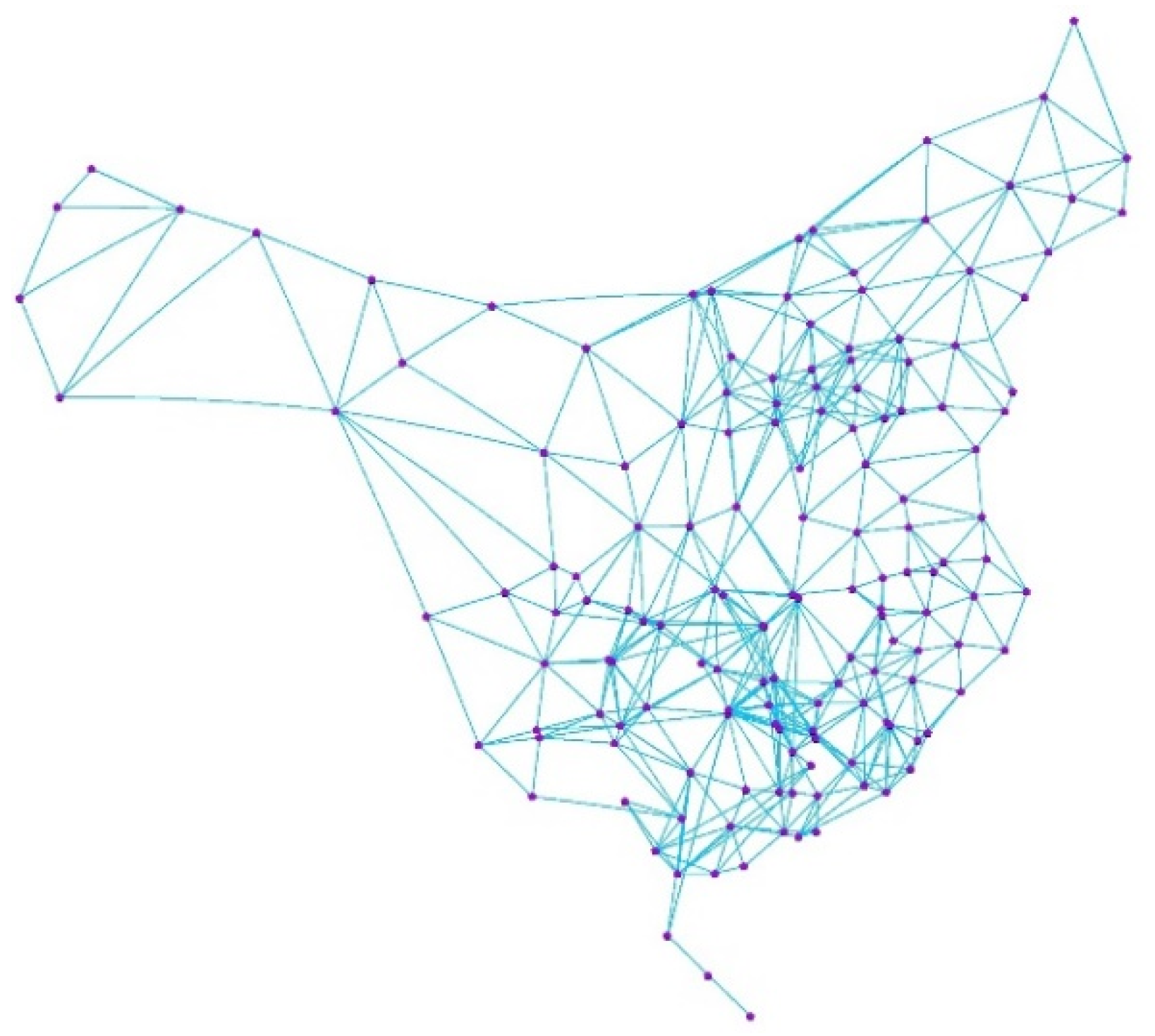
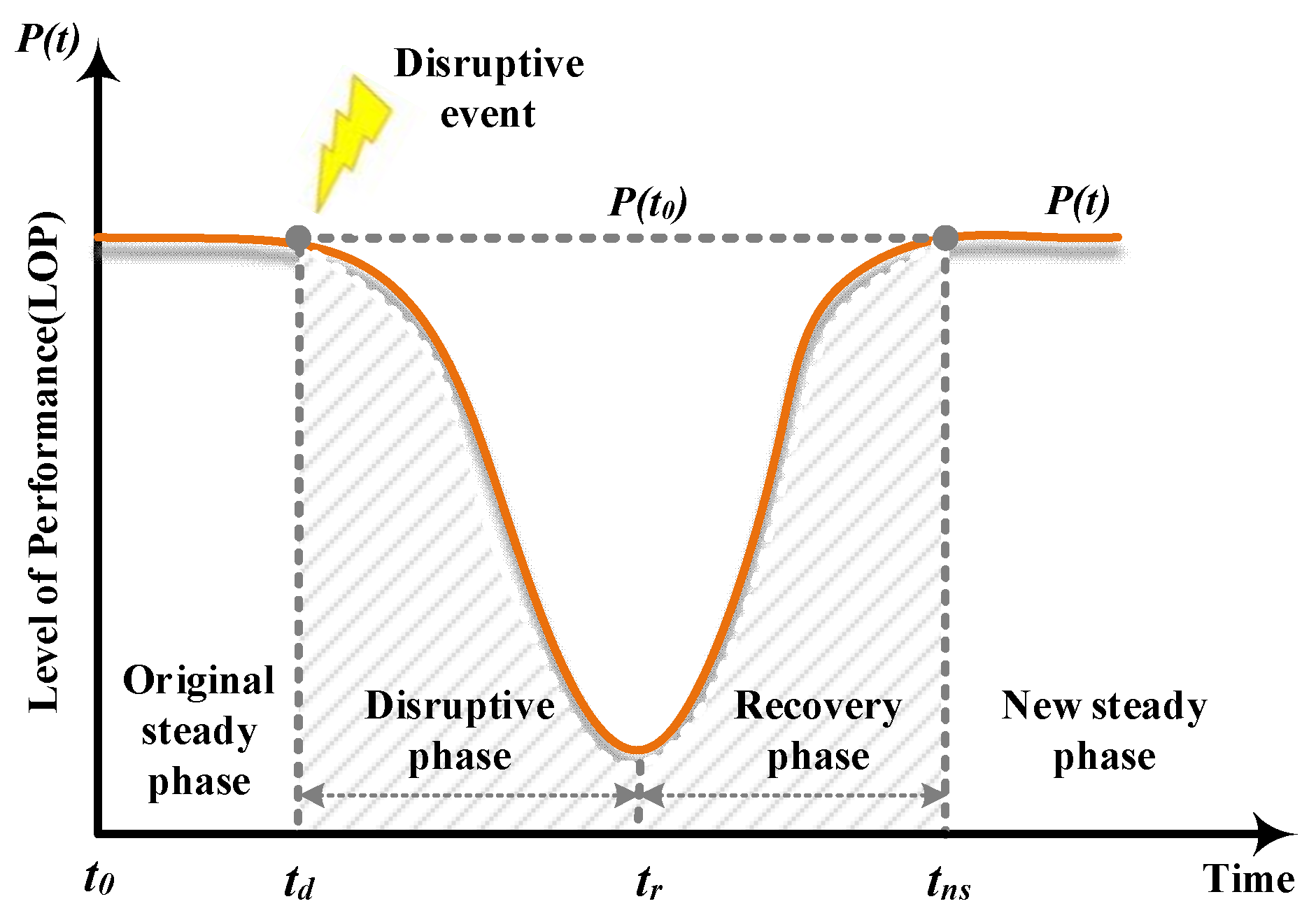


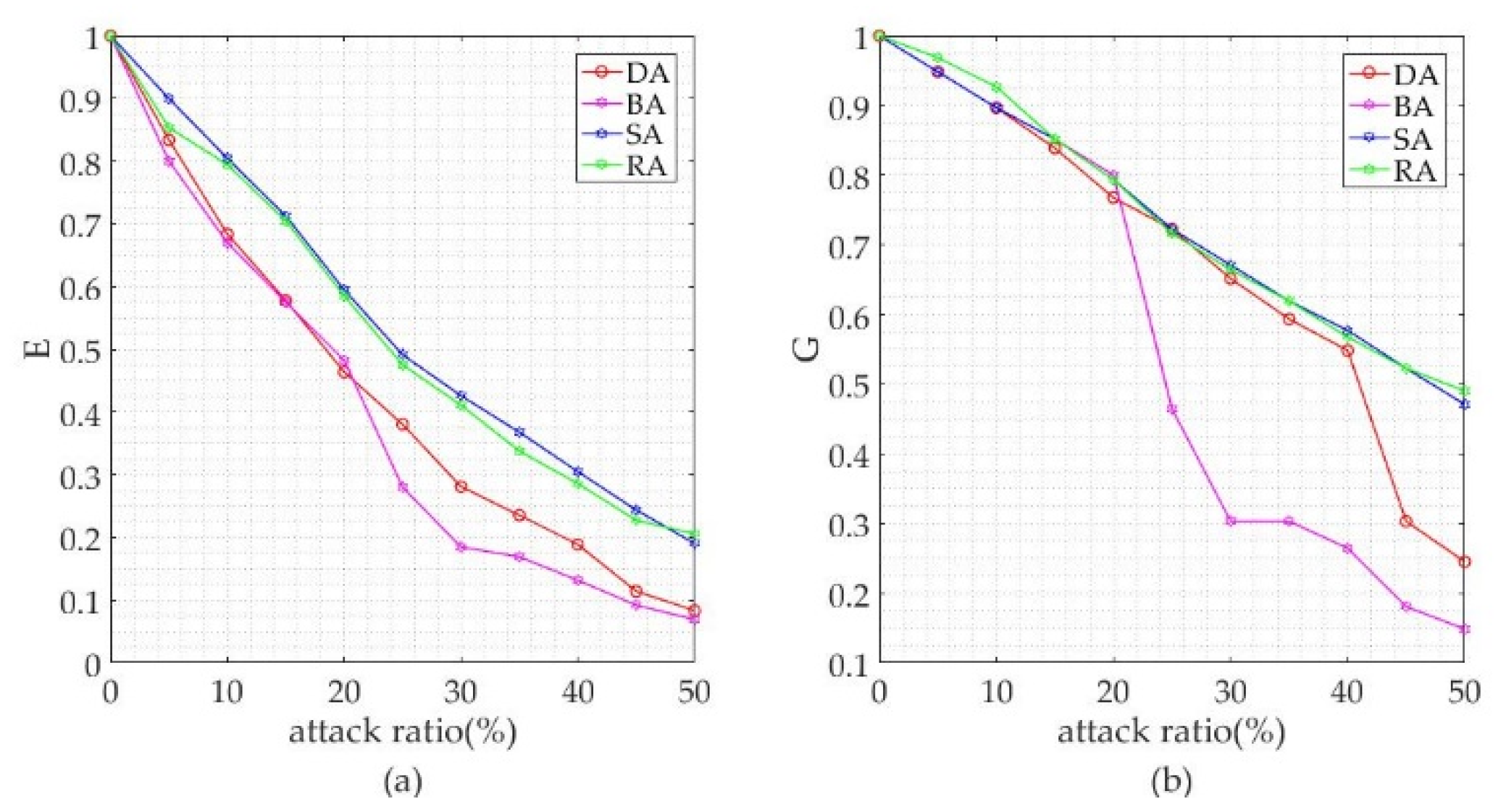
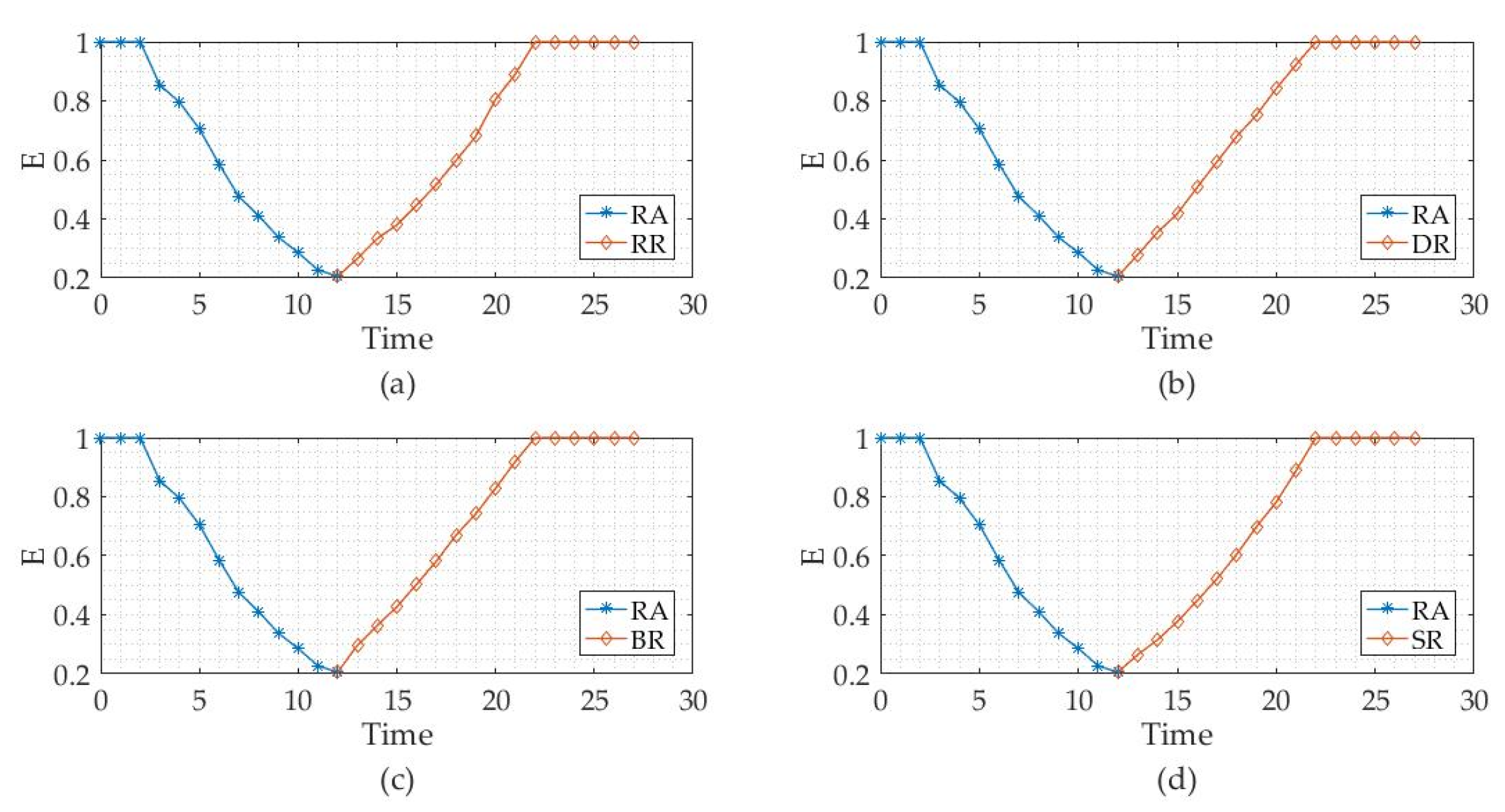
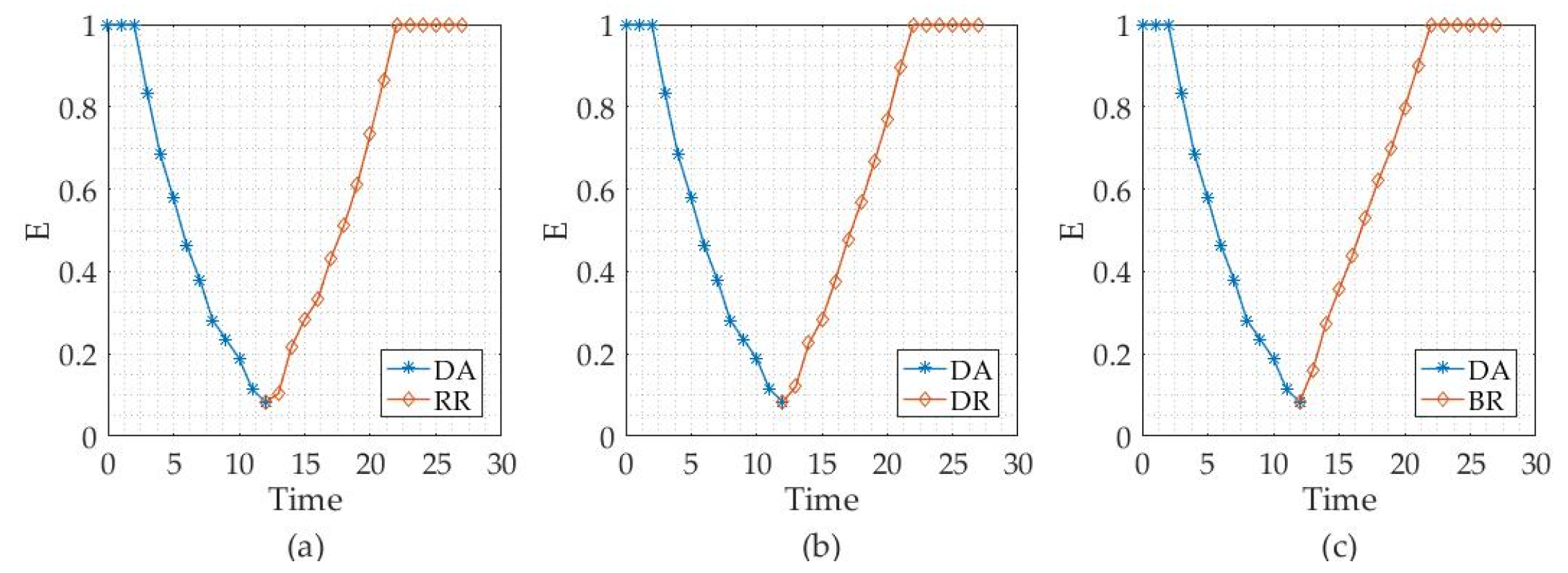
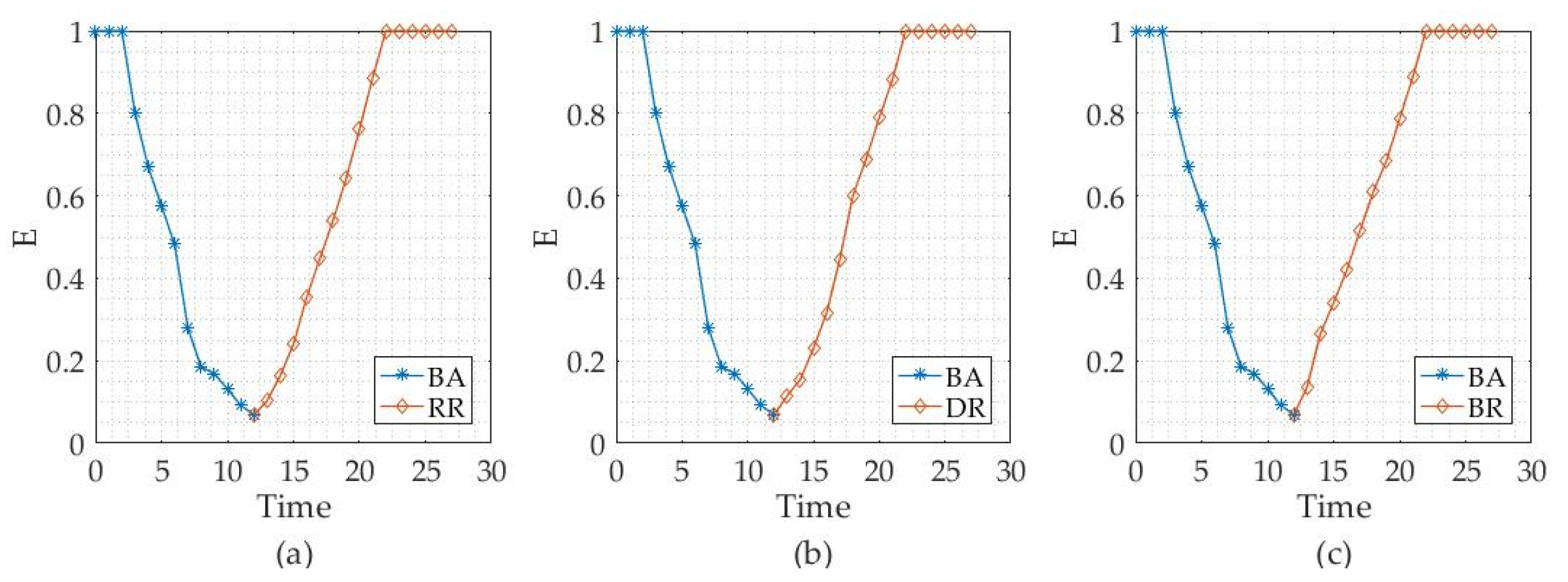
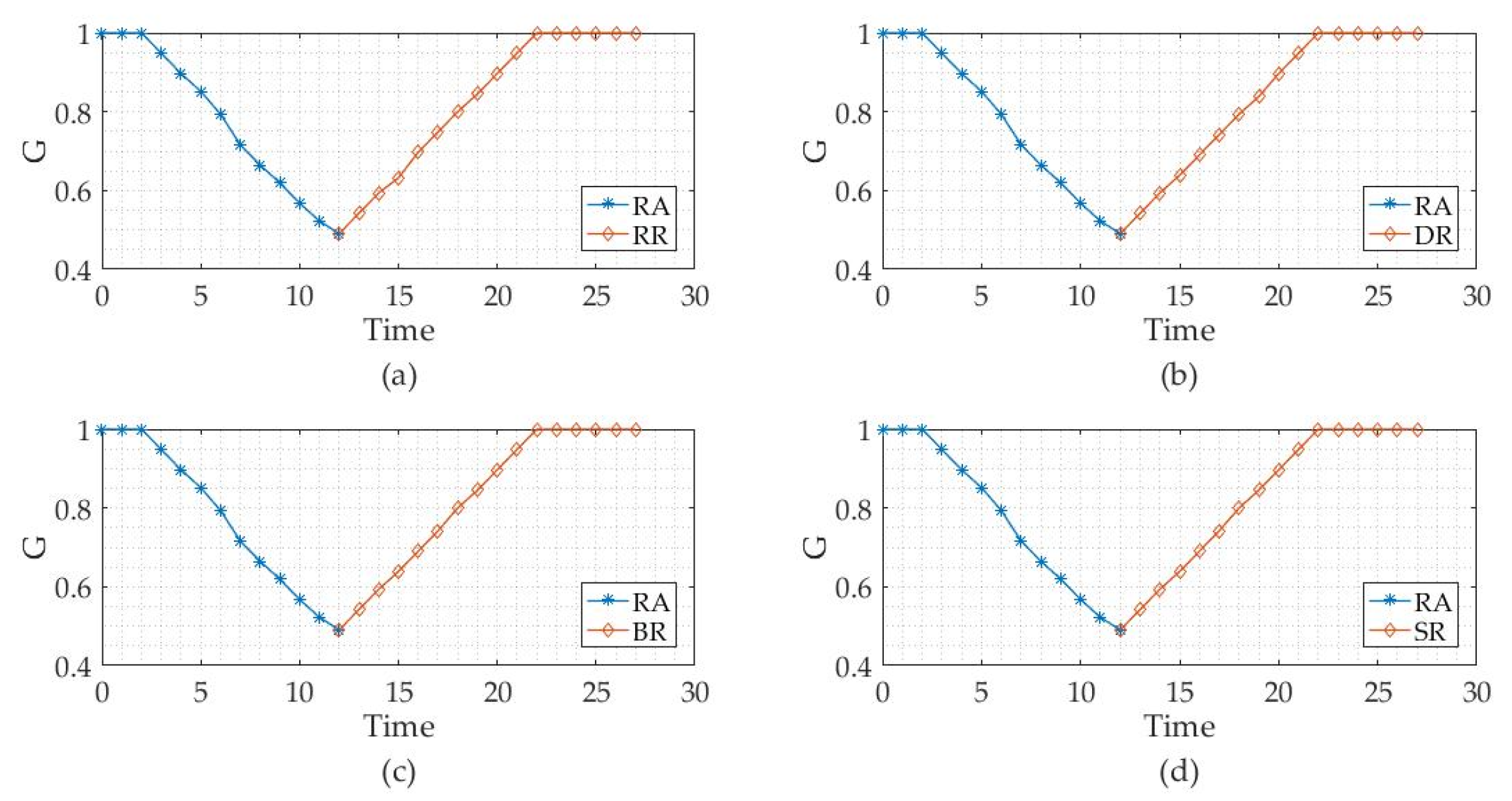
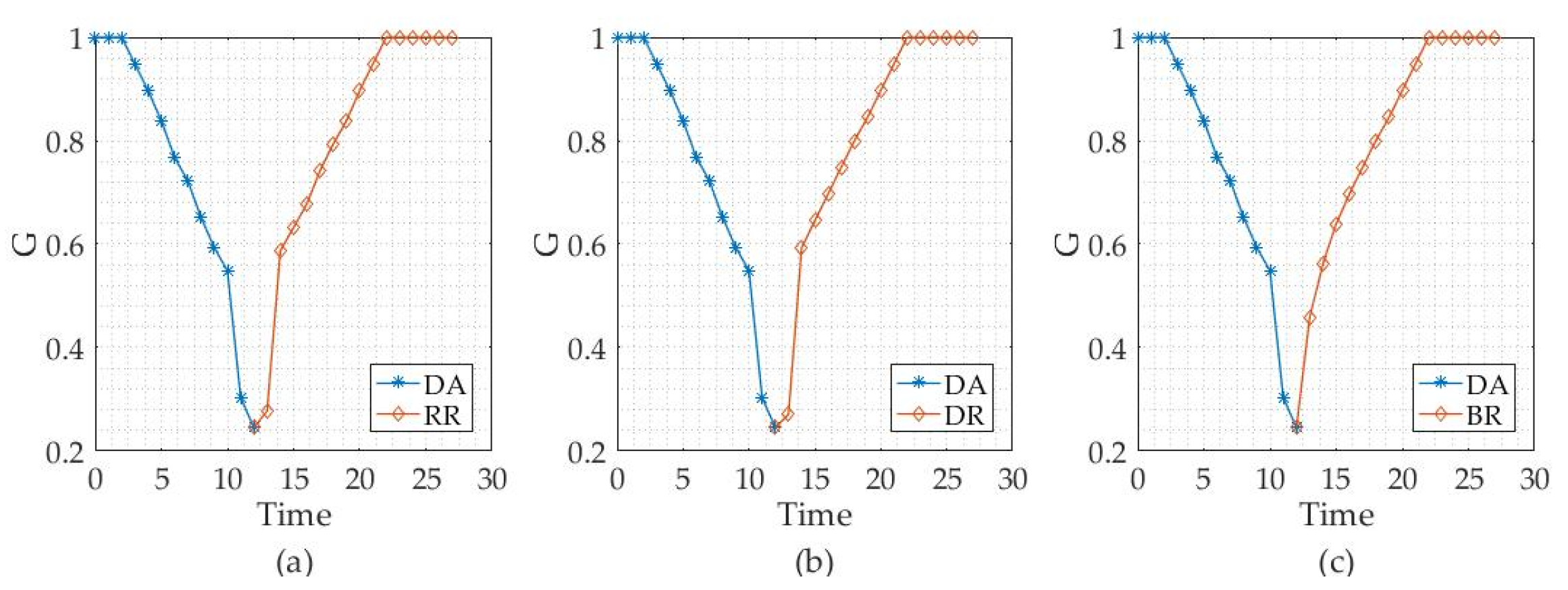
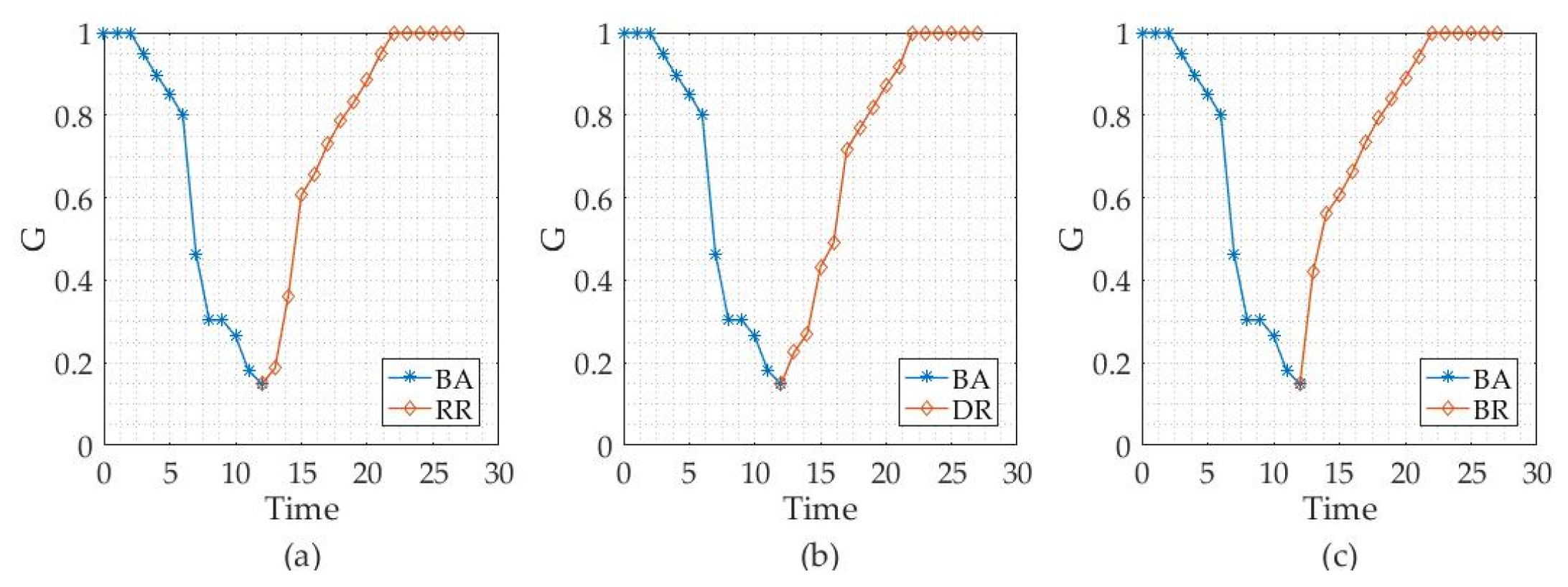
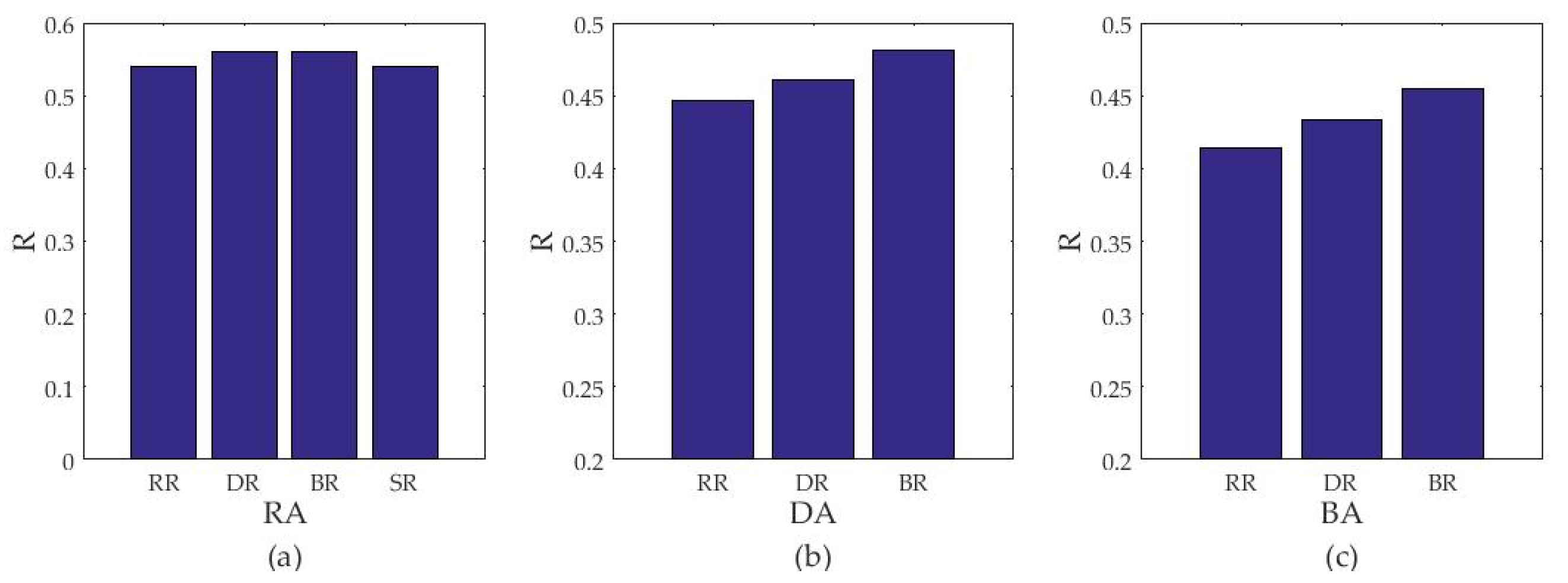
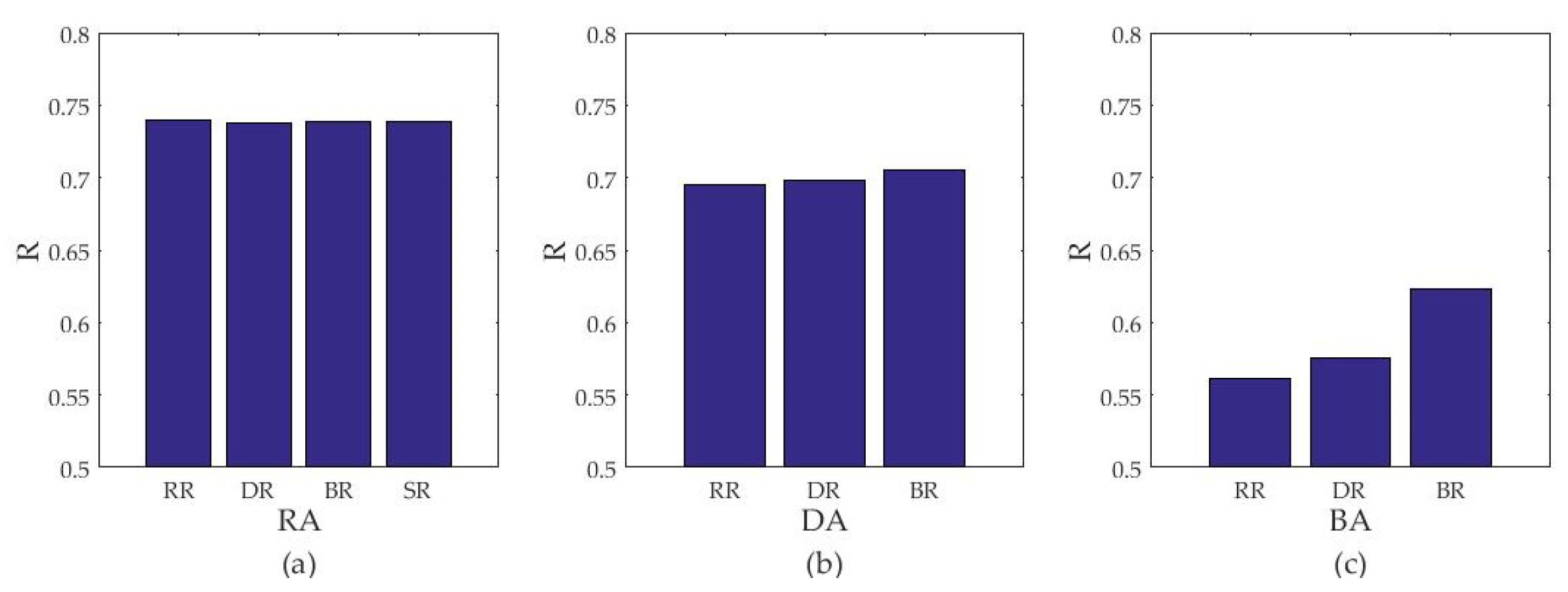

| Parameters | Formula | Annotation |
|---|---|---|
| Degree [55] | For the ATC sector network with nodes, the degree of node represents the number of sectors which have flight flow relationships with node . | |
| Cumulative degree distribution [55] | This indicates the proportion of nodes whose degrees are not less than , where the is the degree distribution. | |
| Strength [46] | Where is the flight flow of sector , the is the neighbor sector set of sector , and represents the number of flights between sector and sector . | |
| Local clustering coefficient [56] | Where is the number of edges in the network formed by the set of adjacent sectors of sector , and is the maximum number of possible edges in this network. | |
| Average shortest path length [57] | Where the total number of sectors is and is the shortest path length between sector and sector . | |
| Betweenness [58] | Where is the total number of shortest paths from sector to sector , and is the number of shortest paths through sector from sector to sector . | |
| Excess average degree [55] | Where the is the degree of neighbor nodes of node , and the is the excess average degree of node and the is the excess average degree of nodes with degree . |
| Top-k | Sectors | K | S | C | B |
|---|---|---|---|---|---|
| 1 | Changsha 01 | 14 | 158 | 0.4945 | 0.0245 |
| 2 | Guangzhou 20 | 13 | 887 | 0.3590 | 0.0377 |
| 3 | Guangzhou 14 | 13 | 1505 | 0.5641 | 0.0125 |
| 4 | Beijing 07 | 13 | 1074 | 0.3462 | 0.0578 |
| 5 | Guangzhou 19 | 13 | 644 | 0.4231 | 0.0497 |
| 6 | Guiyang 04 | 13 | 577 | 0.3077 | 0.1662 |
| 7 | Changsha 02 | 13 | 521 | 0.5385 | 0.0187 |
| 8 | Guangzhou 12 | 12 | 838 | 0.3333 | 0.0707 |
| 9 | Shanghai 20 | 12 | 1068 | 0.4242 | 0.0378 |
| 10 | Guangzhou 17 | 12 | 630 | 0.4848 | 0.0260 |
| Attack Modes | Vulnerability | Resilience |
|---|---|---|
| Random attack | 0.79 | 0.55 |
| Degree attack | 0.92 | 0.46 |
| Betweenness attack | 0.93 | 0.43 |
© 2020 by the authors. Licensee MDPI, Basel, Switzerland. This article is an open access article distributed under the terms and conditions of the Creative Commons Attribution (CC BY) license (http://creativecommons.org/licenses/by/4.0/).
Share and Cite
Wang, X.; Miao, S.; Tang, J. Vulnerability and Resilience Analysis of the Air Traffic Control Sector Network in China. Sustainability 2020, 12, 3749. https://doi.org/10.3390/su12093749
Wang X, Miao S, Tang J. Vulnerability and Resilience Analysis of the Air Traffic Control Sector Network in China. Sustainability. 2020; 12(9):3749. https://doi.org/10.3390/su12093749
Chicago/Turabian StyleWang, Xinglong, Shangfei Miao, and Junqing Tang. 2020. "Vulnerability and Resilience Analysis of the Air Traffic Control Sector Network in China" Sustainability 12, no. 9: 3749. https://doi.org/10.3390/su12093749
APA StyleWang, X., Miao, S., & Tang, J. (2020). Vulnerability and Resilience Analysis of the Air Traffic Control Sector Network in China. Sustainability, 12(9), 3749. https://doi.org/10.3390/su12093749







